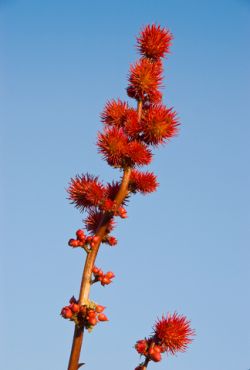 Researchers in Europe and South America have mapped the protein of a biodiesel feedstock, castor beans, in hopes of reducing the poisons in the leftover pulp. This article from The Almagest says researchers from the University of Southern Denmark and hope to be able to get more out of the bean.
Researchers in Europe and South America have mapped the protein of a biodiesel feedstock, castor beans, in hopes of reducing the poisons in the leftover pulp. This article from The Almagest says researchers from the University of Southern Denmark and hope to be able to get more out of the bean.
Countries like Brazil and India grow large quantities of the castor oil beans, which can be refined into bio-diesel. Unfortunately, the beans contain allergens and also the extremely potent poison ricin, and therefore the bean pulp after extraction of the oil cannot be used for animal feed. The animals might become sick or even die from eating castor pulp.
“Therefore we are interested in finding out if it in some way could be possible to eliminate the allergenic proteins and the ricin from the beans, so that the pulp can be used for animal feed”, explains professor Peter Roepstorff, Department of Biochemistry and Molecular Biology at University of Southern Denmark.
The first step towards this has now been taken. Roepstorff and a team of Danish/Brazilian colleagues have used proteomics to map 1875 castor bean proteins.
“Now we know where the proteins are, and we know when during bean development they are produced. Especially the protein ricin and the allergen 2S Albumin are interesting in this context. Unfortunately our research shows that it does not seem to be easy to get rid of them”, says Peter Roepstorff.
The researchers found that the allergens and the deadly ricin poison are low when the beans are young, but as the beans mature and produce desirable oil levels, the ricin and allergen levels increase. The goal is to figure out how to manipulate the proteins to get the high oil levels without all the poisons.

